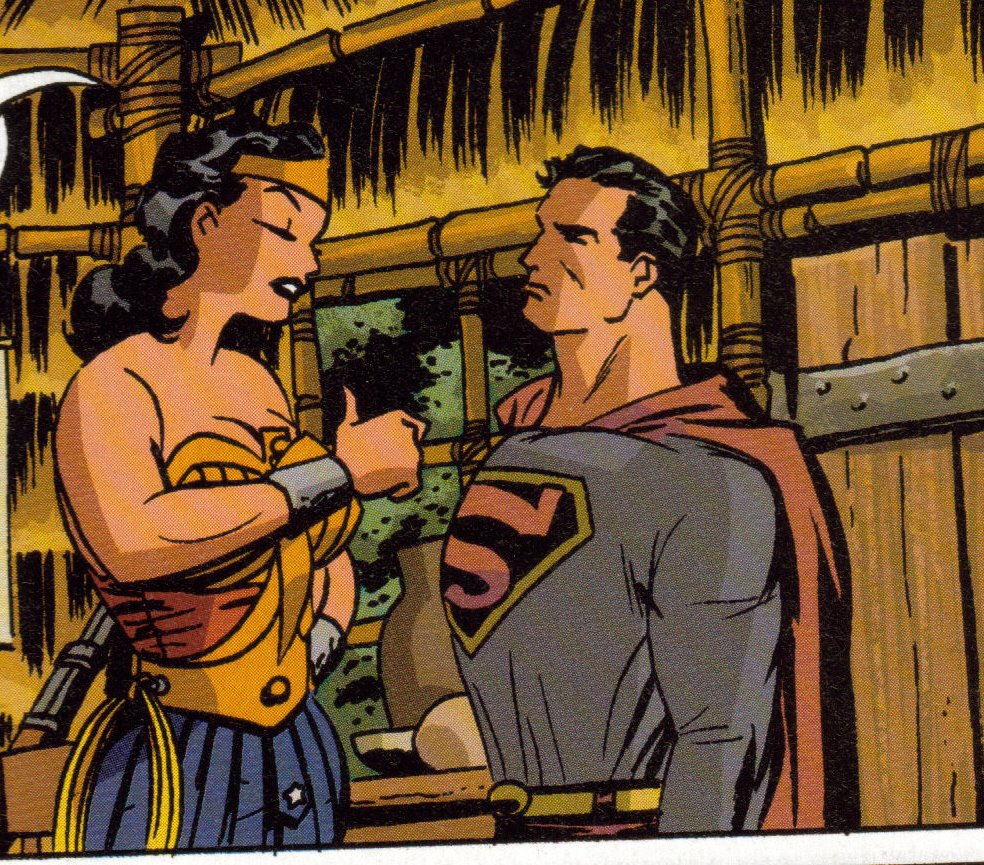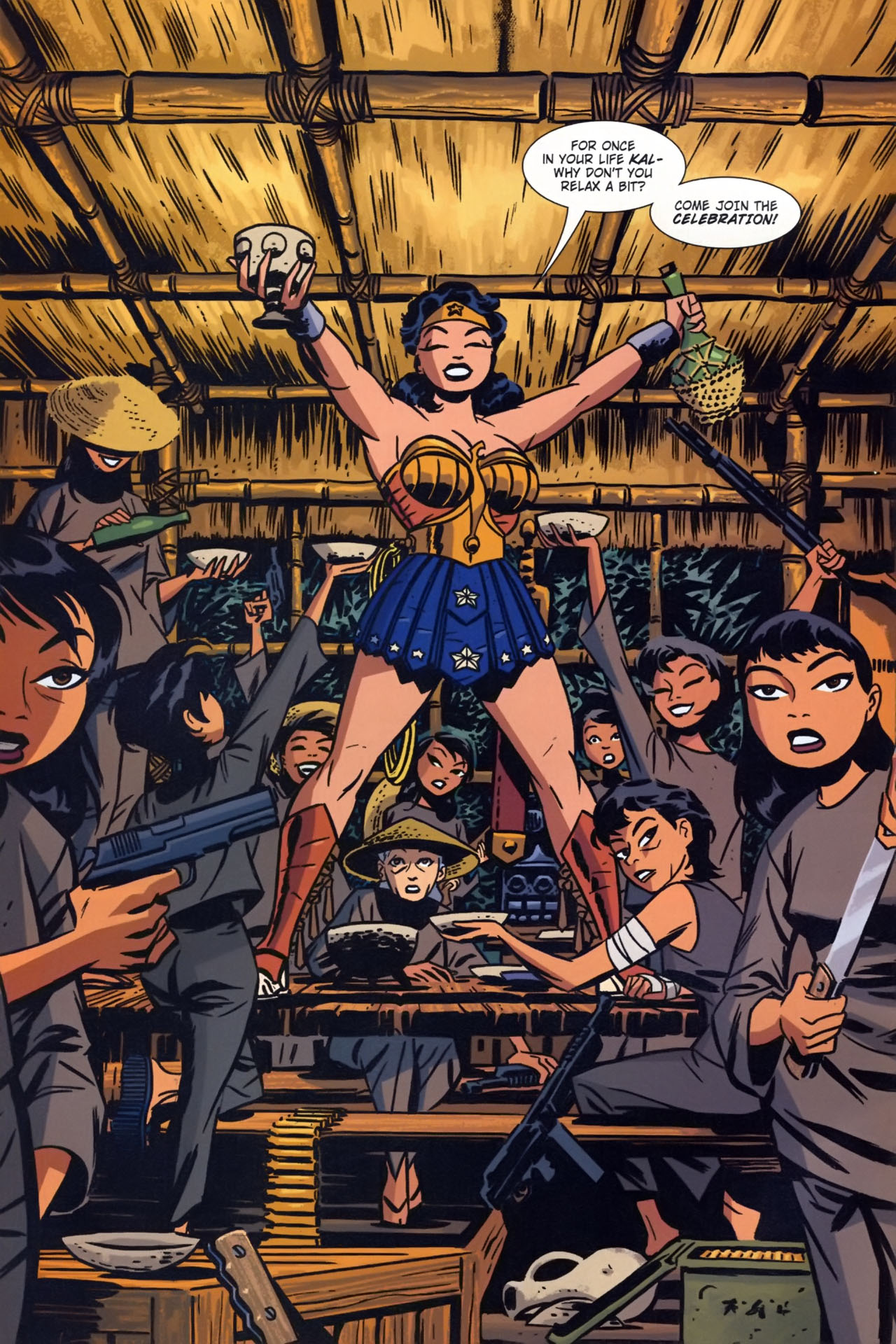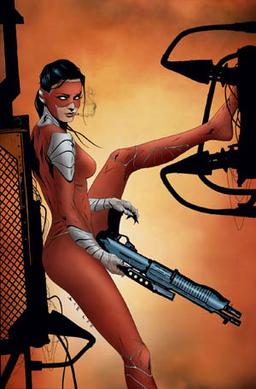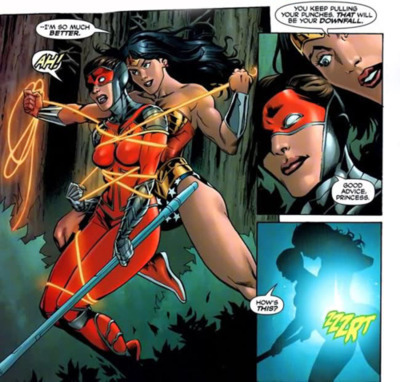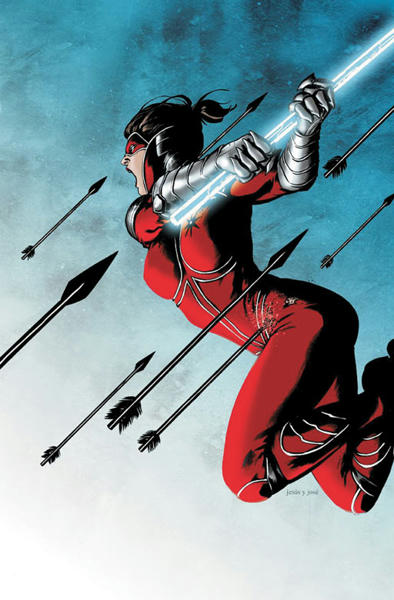Jag vill bara ha en snabb genomgång av vad som gör karaktären sexistist. Det är nån som frågat om det men ärligt talat vet jag bara vad folk här sagt om det. Typ Ymir, Krank etc. Jag är inte alls intresserad av en diskussion om sexism etc men så blir det säkert. Om det är nåt påstående om nånting som en författare till karaktären uttalat eller så vore det jättetrevligt med nån notering.
Nekromanti Wonder woman sexistisk?
- Thread starter Recca
- Start date
Nevermind. Jag hittade en artikel om det. http://www.teenink.com/nonfiction/a...oman-A-Symbol-of-Sexism-and-the-Modern-Woman/
God45
#PrayersForBahakan
- Joined
- 23 Oct 2012
- Messages
- 19,510
Den artikeln missar skapandet av karaktären som en feministisk ikon från början. Den missar också anklagelserna om att det är sexistiskt att Wonder woman dejtar superman i new 52.
Arfert said:Vet inte vad ni i den yngre generationenfeminister tycker om WW. Men om ni skulle anklaga WW för att vara sexistisk så att nån av mina 45+ tant-feminist-polare hör så skulle de nog ge er en rak höger och näsblod. För dem är WW en ikon och hjältinna. I kid you not. Man snackar inte ostraffat skit om deras hjältinna ostraffat.

Måns said:Hörrni, läs artikeln istället.
1. Det framgår att WW skapades som en motpol till alla supermän.
2. Den snackar inte skit om WW, utan disskuterar hur/om WW:s status har förändrats sedan 40-talet fram till idag.
I all välmening
Arfert said:Jag talade inte om artikeln utom ursprungsinlägget.. "Vad gör karaktären sexistisk?"-frågeställningen. Som verkar utgå ifrån att WW är det. Eller?
Måns said:Som jag tolkar det är det mer som i "varför anser vissa att WW är sexistisk? Vilka argument har presenterats?" Inte som i "Varför är WW sexistisk? Ge mig argument så att jag också kan påstå det!"
Arfert said:Då undrar jag lite förvånat vilka som tycker det? Och är det för att hon har bara lår? Typ baddräkt?
Måns said:Det var som jag förstår det själva poängen med inlägget. "Vad (om något) är det som gör WW sexistisk?"
Ursäkta om jag lägger ord i munnen på dig Recca.
God45
#PrayersForBahakan
- Joined
- 23 Oct 2012
- Messages
- 19,510
Wonder woman var bättre in the good old bondage Days i och för sigVet inte vad ni i den yngre generationenfeminister tycker om WW. Men om ni skulle anklaga WW för att vara sexistisk så att nån av mina 45+ tant-feminist-polare hör så skulle de nog ge er en rak höger och näsblod. För dem är WW en ikon och hjältinna. I kid you not. Man snackar inte ostraffat skit om deras hjältinna ostraffat.

Låt oss citera wikipedia:
Themes[edit] Marston's "Wonder Woman" is an early example of bondage themes that were entering popular culture in the 1930s. Physical submission appears again and again throughout Marston's comics work, with Wonder Woman and her criminal opponents frequently being tied up or otherwise restrained, and her Amazonian friends engaging in frequent wrestling and bondage play. These elements were softened by later writers of the series, who dropped such characters as the Nazi-like blond female slaver Eviless completely, despite her having formed the original Villany Inc. of WW's enemies (in Wonder Woman #28, the last by Marston).
Though Marston had described female nature as submissive, in his other writings and interviews[SUP][citation needed][/SUP] he referred to submission as a noble practice and did not shy away from the sexual implications, saying:
The only hope for peace is to teach people who are full of pep and unbound force to enjoy being bound... Only when the control of self by others is more pleasant than the unbound assertion of self in human relationships can we hope for a stable, peaceful human society... Giving to others, being controlled by them, submitting to other people cannot possibly be enjoyable without a strong erotic element.[SUP][10][/SUP]He purposely tried to induce eroticism in readers through these images of submission, because he aimed to condition readers to becoming more readily accepting to submission to loving authorities rather than being so assertive to their own destructive egos.
About male readers, he later wrote: "Give them an alluring woman stronger than themselves to submit to, and they'll be proud to become her willing slaves!".[SUP][11][/SUP]
Marston combined these themes with others, including restorative and transformative justice, rehabilitation, regret and its role in civilization. These appeared often in his depiction of the near-ideal Amazon civilization of Paradise Island, and especially its Reform Island penal colony, which played a central role in many stories, and was the "loving" alternative to retributive justice of the world run by men. These themes are particularly evident in his last story, in which prisoners freed by Eviless, who have responded to Amazon rehabilitation and now have good dominance/submission, stop her and restore the Amazons to power.
Some of these themes continued on in Silver Age characters who may have been influenced by Marston, notably Saturn Girl and Saturn Queen, who (like Eviless and her female army) are also from Saturn, also clad in tight dark red bodysuits, also blond or red-haired, and also have telepathic powers.[SUP][12][/SUP] Stories involving the latter have been especially focused on the emotions involved in changing sides from evil to good, or the use of power over minds even to do good. Wonder Woman's golden lasso and Girdle of Venus in particular were the focus of many of the early stories, and have the same capability to influence people for good in the short term that Transformation Island offered in the longer term. The Venus Girdle was an allegory for Marston's theory of "sex love" training, where people can be "trained" to embrace submission through eroticism.[SUP][citation needed] [/SUP]
Arfert said:Bondage är väl trevligt. Kan vara därför att Bettie Page är också en idol bland mina ovan nämnda väninnor.
God45
#PrayersForBahakan
- Joined
- 23 Oct 2012
- Messages
- 19,510
De borde gå tillbaks mer till det. Det kan inte vara värre än Amazons attack i alla fallBondage är väl trevligt. Kan vara därför att Bettie Page är också en idol bland mina ovan nämnda väninnor.
Arfert said:De är barn av en mer liberal tidsanda.
Måns said:Ingen utöver ni två har nämnt bondage så det är nog svårt att avgöra huruvida "de" är mer liberala tack vara den påstått mer liberala tidsandan än några andra... Och vad bondage isf har med saken att göra.
God45
#PrayersForBahakan
- Joined
- 23 Oct 2012
- Messages
- 19,510
Varför kollar du inte in länkarna jag postade högre uppIngen utöver ni två har nämnt bondage så det är nog svårt att avgöra huruvida "de" är mer liberala tack vara den påstått mer liberala tidsandan än några andra... Och vad bondage isf har med saken att göra.
Arfert said:
God45 said:Oh, jag kan toppa det där!
http://superdickery.com/images/stories/bondage/wwnakedchainedcu1986.jpg
http://superdickery.com/images/stories/bondage/277_4_203.jpg
http://superdickery.com/images/stories/bondage/flash_no219_apr_2005_dc_my.jpg
http://superdickery.com/images/stories/bondage/3396_4_00067.jpg
http://superdickery.com/images/stories/bondage/277_4_231.jpg
http://superdickery.com/images/stories/bondage/05kp2.jpg
Arfert said:Jag letade inte.
Mogger
Hipsteranka
Jo, jag vet. Det framgår också i artikeln. Jag undrar mest vem det är ni pratar med? Och vad ni försöker säga. Artikeln nämner visserligen "critics" som menar att de sexuella anspelningarna objektifierar WW, men vilka de är har jag ingen aning om, och eftersom jag själv aldrig har läst WW har jag ingen åsikt i frågan.God45;n3013 said:Varför kollar du inte in länkarna jag postade högre uppWonder woman skapades med en jäkla massa bondage grejer bakom sig. Läs på om Marston vet jag

Troberg
Sinister eater
- Joined
- 27 Jun 2001
- Messages
- 17,711
Är frågan om WW är BDSM-influerad relevant för frågan om WW är sexistisk?
För mig är frågeställningarna ortogonala, de har ingen bäring alls på varandra.
För mig är frågeställningarna ortogonala, de har ingen bäring alls på varandra.
Måns said:Precis så, ja.
God45
#PrayersForBahakan
- Joined
- 23 Oct 2012
- Messages
- 19,510
Ett större problem är egentligen att som det sett ut ett bra tag borde Wonder Woman inte vara med i The Justice League. Vi har en grupp full med folk som tar sina regler mot att döda folk super alvarligt och sedan har vi Wonder woman som dödar folk höger, vänster och i mitten. Alltså, det funkar när det är Frank Miller bakom spakarna eftersom det är vad det är och det funkar i ww2 grejerna där alla dödar folk. men i den moderna Justice leaguen är det skumt. Jag snackar inte ens om Maxwell Lord grejen utan att hon avslutar superskurkar vid minsta provokation.
Arfert said:Millers serier är alltid ett eget universum, på nåt sätt.
God45 said:Ja, det har blivit mer tydligt på senare tid i och med All star.
Jag vet att Miller har sina... Problem. Holy terror är liksom... Wow! Men jag kan inte hjälpa att gilla hans take på Batman och The Justice League.
Cybot said:Det är väl därför Wonder Woman är bättre än resten av Justice League. De övriga har en rad skrupler som bara maskerar att innerst inne så finns det ett ID som VILL göra onda saker. Innerst inne vill Batman döda folk, Superman vill bli Emperor of All Earth osv. Wonder Woman har inte några sådana problem och sätter inte upp några spärrar för att kontrollera sig själv. Lex Luthor? Dö. Galactus? Dö. Jokern? Dö. Poison Ivy? Dö. Catwoman? Bondage-spanking games forever...
Allt skulle vara bättre om Wonderwoman fick sin vilja igenom
Efter att ha läst artikeln, och den här tråden, är jag fortfarande inte säker på om Wonder Woman är sexistisk eller inte. Någon som kan spoila svaret?
Detv största problemet med WW är att hon är en rätt tråkig figur. När hon skapades var superhjältegenren rätt ung, och det räckte egentligen med ett hon var en kvinna för att hon skulle utmärka sig. Idag känns det som om det behövs mer för att hålla läsarens intresse vid liv. Jag testade första albumet av den nystartade serien av Brian Azzarello, och den var rätt okej, men jag upplevde att WW själv var den minst intressanta figuren i serien, vilket inte är speciellt bra.
/tobias
Detv största problemet med WW är att hon är en rätt tråkig figur. När hon skapades var superhjältegenren rätt ung, och det räckte egentligen med ett hon var en kvinna för att hon skulle utmärka sig. Idag känns det som om det behövs mer för att hålla läsarens intresse vid liv. Jag testade första albumet av den nystartade serien av Brian Azzarello, och den var rätt okej, men jag upplevde att WW själv var den minst intressanta figuren i serien, vilket inte är speciellt bra.
/tobias
Arfert said:Ja ska spola och säga "nej, generellt inte". Utom i fan-art på Deviant Art.
Ond bråd död
Swashbuckler
Nu har jag inte läst nåt WW mer än det som finns på superdickery, men det hindrar mig tydligen inte från att ha en åsikt. WW framställs sexistiskt som de flesta andra hjältinnor, men det här från Wikipedia låter ju lite sexistiskt:
"...med hjälp av sin speciella amazonträning kunde hon fokusera sin mentala energi på att ge kroppen superstyrka. Alla kvinnor hade en latenta förmåga att lära sig detta. Om Wonder Woman bands av en man tappade hon sina krafter, vilket ledde till ett flertal scener som kritiserats för att vara exempel på bondage-motiv med erotiska undertoner."
Tydligen en förmåga som bara kvinnor har. Och grejen med att bli bunden av män kan ju inte bli annat än hysteriskt.
Om bondage/WW är sexistiskt så vill jag nog säga ja. Såna här definitioner brukar avgöras av de mest lättkränkta i samhället, så allt mellan himmel och jord är sexistiskt. Själv tycker jag att WW är en rätt harmlös men kul skapelse, som en gång var väldigt feministisk, men som idag inte är tillräckligt extrem.
"...med hjälp av sin speciella amazonträning kunde hon fokusera sin mentala energi på att ge kroppen superstyrka. Alla kvinnor hade en latenta förmåga att lära sig detta. Om Wonder Woman bands av en man tappade hon sina krafter, vilket ledde till ett flertal scener som kritiserats för att vara exempel på bondage-motiv med erotiska undertoner."
Tydligen en förmåga som bara kvinnor har. Och grejen med att bli bunden av män kan ju inte bli annat än hysteriskt.
Om bondage/WW är sexistiskt så vill jag nog säga ja. Såna här definitioner brukar avgöras av de mest lättkränkta i samhället, så allt mellan himmel och jord är sexistiskt. Själv tycker jag att WW är en rätt harmlös men kul skapelse, som en gång var väldigt feministisk, men som idag inte är tillräckligt extrem.
God45
#PrayersForBahakan
- Joined
- 23 Oct 2012
- Messages
- 19,510
Det där med mental energi är ju något från golden age och har inte varit canon på mer än 60 år så jag tror vi kan ignorera detOnd bråd död;n3109 said:Nu har jag inte läst nåt WW mer än det som finns på superdickery, men det hindrar mig tydligen inte från att ha en åsikt. WW framställs sexistiskt som de flesta andra hjältinnor, men det här från Wikipedia låter ju lite sexistiskt:
"...med hjälp av sin speciella amazonträning kunde hon fokusera sin mentala energi på att ge kroppen superstyrka. Alla kvinnor hade en latenta förmåga att lära sig detta. Om Wonder Woman bands av en man tappade hon sina krafter, vilket ledde till ett flertal scener som kritiserats för att vara exempel på bondage-motiv med erotiska undertoner."
Tydligen en förmåga som bara kvinnor har. Och grejen med att bli bunden av män kan ju inte bli annat än hysteriskt.
Om bondage/WW är sexistiskt så vill jag nog säga ja. Såna här definitioner brukar avgöras av de mest lättkränkta i samhället, så allt mellan himmel och jord är sexistiskt. Själv tycker jag att WW är en rätt harmlös men kul skapelse, som en gång var väldigt feministisk, men som idag inte är tillräckligt extrem.
Nej, WW är inte sexistisk. Inte mer än att Batman är fascistisk eller Superman är rasistisk. Men de har funnits med i snart hundra år så en del tvivelaktiga grejer har dykt upp här och var.
Jag har ingen aning. Jag läser inte DC-serier typ alls; undantaget en del av deras gamla Vertigoprylar. Jag är nästan helt obekant med Wonder Woman.Recca;n2969 said:Det är nån som frågat om det men ärligt talat vet jag bara vad folk här sagt om det. Typ Ymir, Krank etc.
Det lilla jag sett är väl att hon framställs med samma male gaze och extremt tighta och hyfsat avslöjande dräkt som alla andra superhjältinnor (mer eller mindre). Men det är som sagt en väldigt ytlig analys eftersom jag inte vet så mycket om karaktären och tycker att DC's hjältar är enormt mycket mindre intressanta än t.ex. Marvels olika X-titlar.
//Krank, superman och batman, gäsp.
chrull
Stockholm Kartell
- Joined
- 17 May 2000
- Messages
- 8,425
Jag har läst lite WW och jag tycker ungefär såhär:
WW framställs vanligtvis precis som alla andra superhjältinnor. Det är mycket hud och sexiga poser. Om det är tillräckligt för att göra henne sexistisk för dig så är hon det. För dig.
Karaktären i sig är dock ett försök att bryta mot den vanligen så mansdominerade superhjälteserien. Hon är tuff och stark och låter för det mesta ingen bestämma vad hon ska göra eller hur hon ska bete sig. I flera fall är hon klart feministisk och slåss för kvinnors rättigheter. Är det tillräckligt för att göra henne feministisk för dig så är hon det.
Sanningen är ju dock att hon har hanterats av massor av olika författare, tecknade och redaktörer. De flesta som gjort det har antagligen helt struntat i huruvida hon är feminist eller inte.
WW framställs vanligtvis precis som alla andra superhjältinnor. Det är mycket hud och sexiga poser. Om det är tillräckligt för att göra henne sexistisk för dig så är hon det. För dig.
Karaktären i sig är dock ett försök att bryta mot den vanligen så mansdominerade superhjälteserien. Hon är tuff och stark och låter för det mesta ingen bestämma vad hon ska göra eller hur hon ska bete sig. I flera fall är hon klart feministisk och slåss för kvinnors rättigheter. Är det tillräckligt för att göra henne feministisk för dig så är hon det.
Sanningen är ju dock att hon har hanterats av massor av olika författare, tecknade och redaktörer. De flesta som gjort det har antagligen helt struntat i huruvida hon är feminist eller inte.
Anarchclown
Swashbuckler
Jag vill tillägga att New 52-versionen av Wonder Woman skiljer sig rätt rejält från tidigare varianter och är helt jävla underbar. De har inte ändrat dräkten särskilt mycket (eftersom den är ikonisk vid det här laget, så dum den nu är). Däremot är hennes personlighet aningen annorlunda och hennes bakgrund helt omgjord till att vara rätt awesome. Grekiska gudarna figurerar mycket friskt i historien och den spinn de gjort på dem påminner om "The Endless" från Sandman lite grann. Riktigt bra skit.


